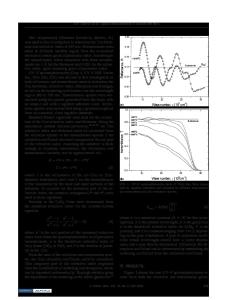Synthesis strategies for improving the performance of doped-BaZrO 3 materials in solid oxide fuel cell applications
- PDF / 592,074 Bytes
- 15 Pages / 584.957 x 782.986 pts Page_size
- 83 Downloads / 784 Views
Synthesis strategies for improving the performance of doped-BaZrO3 materials in solid oxide fuel cell applications Lei Bi and Enrico Traversaa) Physical Sciences and Engineering Division, Solar and Photovoltaics Engineering Research Center, King Abdullah University of Science and Technology (KAUST), Thuwal 23955-6900, Saudi Arabia (Received 25 June 2013; accepted 25 June 2013)
Solid oxide fuel cells (SOFCs) offer an efficient energy conversion technology for alleviating current energy problems. High temperature proton-conducting (HTPC) oxides are promising electrolytes for this technology, since their activation energy is lower than that of conventional oxygen-ion conductors, enabling the operating temperature reduction at 600 °C. Among HTPC oxides, doped BaZrO3 materials possess high chemical stability, needed for practical applications. Though, poor sinterability and the resulting large volume of highly resistive grain boundaries hindered their deployment for many years. Nonetheless, the recently demonstrated high proton conductivity of the bulk revived the attention on doped BaZrO3, stimulating research on solving the sintering issues. The proper selection of dopants and sintering aids was demonstrated to be successful for improving the BaZrO3 electrolyte sinterability. We here briefly review the synthesis strategies proposed for preparing BaZrO3-based nanostructured powders for electrolyte and electrodes, with the aim to improve the SOFC performance.
I. INTRODUCTION
The increasing demand for energy all around the world and the high level of pollution generated by fossil fuel combustion, the conventional way of energy supply, require new environmental-friendly energy conversion systems with high efficiency. To this aim, fuel cells, which directly convert chemical energy into electricity, provide a promising alternative option.1 Moreover, fuel cells are versatile and can generate electricity from several W to MW range, since their efficiency does not depend on their size, meeting the demand from portable to stationary applications.1 Solid oxide fuel cells (SOFCs), regarded as one of the most promising fuel cell types,2 have additional advantages over the other types of fuel cells, including fuel flexibility, all solid components, use of nonprecious catalysts, etc.3 However, the conventional SOFC technology uses oxygenion conductor electrolytes, such as yttria-stabilized zirconia (YSZ), and thus needs operation temperatures up to 1000 °C due to the YSZ ionic conductivity.4,5 However, working at such a high temperature causes many problems, including the reduction of cell life time, interfacial diffusions, sealing problems, etc.6 Therefore, the reduction of the SOFC working temperature is the current trend in SOFC development.7 a)
Address all correspondence to this author. e-mail: [email protected] DOI: 10.1557/jmr.2013.205 J. Mater. Res., Vol. 29, No. 1, Jan 14, 2014
http://journals.cambridge.org
Downloaded: 22 May 2014
One strategy to reduce the working temperature for SOFCs is decreasing the YSZ ele
Data Loading...











